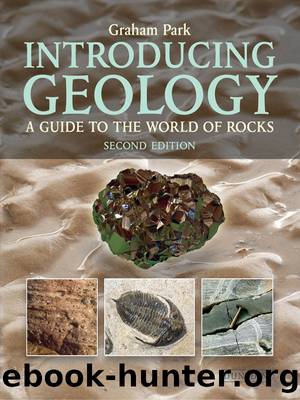Introducing Geology by Park Graham

Author:Park, Graham
Language: eng
Format: epub
Publisher: Dunedin Academic Press
9. Fossils – a history of life
Fossils are among the most interesting objects in the natural world. Finding a perfectly preserved specimen of an animal from its tomb within a rock is an exciting event and one that has prompted many young people to study geology.
Fossils have of course been known since ancient times and have occasioned much speculation as to their origins, but it was not until the early nineteenth century that the serious study of fossils (palaeontology) commenced with the work of Baron Cuvier in Paris. Cuvier studied the anatomy of animal skeletons and showed how fossil animals could be reconstructed from their incomplete fossilised remains. There was considerable controversy in those days about the significance of fossils. Some, the catastrophists, believed that fossils were the remains of animals that had perished during a single great event – the biblical flood; however, the view that prevailed held that fossils represented a catalogue of the animal and plant life that has existed over the long period of geological time. The latter view was strongly influenced by James Hutton’s observations in the latter part of the 18th century that the Earth has a very long history, made up of a series of events similar to those that could be observed at the present time – erosion, sedimentation, vulcanicity etc., and that there was ‘no vestige of a beginning, no prospect of an end’.
Nature and preservation of fossils
Fossils are the remains or traces of onceliving organisms. Complete preservation of dead organisms is quite rare, although some remarkably well-preserved carcasses of the extinct woolly mammoth have been recovered from frozen tundra in Siberia, for example. In most cases the soft tissues of animals have been destroyed and only hard parts – like vertebrate skeletons and mollusc shells – are preserved. With the passage of time, the hard parts of fossils may be replaced by minerals such as calcite, silica or iron compounds, but the detailed structure is often preserved in minute detail so that the organism’s anatomy can be reconstructed. In some cases the original material has been completely dissolved but the impression of the organism, called a mould, has been left imprinted in the rock. Even the most minute unicellular organisms can be preserved, in silica for example, and can be studied under the microscope.
Tracks and other traces of organisms are also considered to be fossils – for example dinosaur footprints or worm burrows – and are valuable in enabling the palaeontologist to reconstruct the environment in which such animals lived, and something of their habits.
Only a tiny proportion of past life ever finds its way into the fossil record. There are various reasons for this. Much organic material is consumed by other life forms, or decays unrecognisably. The conditions for survival are untypical and depend on rapid burial, by mud or volcanic ash for example, at the bottom of the sea or in a lake. Consequently the fossil record has to be regarded as incomplete and unrepresentative. Many types of extinct organisms, especially those with no hard parts, will probably never be known.
Download
This site does not store any files on its server. We only index and link to content provided by other sites. Please contact the content providers to delete copyright contents if any and email us, we'll remove relevant links or contents immediately.
Man-made Catastrophes and Risk Information Concealment by Dmitry Chernov & Didier Sornette(5674)
The Revenge of Geography: What the Map Tells Us About Coming Conflicts and the Battle Against Fate by Kaplan Robert D(3966)
Zero Waste Home by Bea Johnson(3661)
In a Sunburned Country by Bill Bryson(3378)
COSMOS by Carl Sagan(3364)
Good by S. Walden(3361)
The Fate of Rome: Climate, Disease, and the End of an Empire (The Princeton History of the Ancient World) by Kyle Harper(2884)
Camino Island by John Grisham(2723)
A Wilder Time by William E. Glassley(2701)
Organic Mushroom Farming and Mycoremediation by Tradd Cotter(2572)
The Ogre by Doug Scott(2510)
Human Dynamics Research in Smart and Connected Communities by Shih-Lung Shaw & Daniel Sui(2433)
Energy Myths and Realities by Vaclav Smil(2387)
The Traveler's Gift by Andy Andrews(2307)
9781803241661-PYTHON FOR ARCGIS PRO by Unknown(2275)
Inside the Middle East by Avi Melamed(2234)
Birds of New Guinea by Pratt Thane K.; Beehler Bruce M.; Anderton John C(2182)
A History of Warfare by John Keegan(2108)
Ultimate Navigation Manual by Lyle Brotherton(2058)
